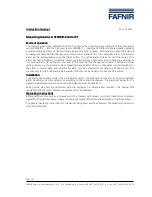
CMT2380F64
www. cmostek. com
Rev 0.3 | 48 / 83
When the PA is switched fast, the varying input impedance will disturb the output frequency of the VCO instantaneously. The
effect is called VCO pulling. It will generate the spurious and spurson the spectrum around the desired carrier. The PA spurs
can be reduced to a minimum instantaneously by the PA output power ramping. CMT2380F64 has a built-in PA ramping
mechanism. When the PA Ramp is turned on, the PA output power can ramp the desired amplitude in a pre-configuredrate, so
as to reduce the spurs. In FSK mode, the signal can be filtered by a Gaussian Filter before transmitted, e.g. GFSK, which can
reduce the spectral width and interference with neighboring channels.
According to different application requirements, the user can design a Pa matching network to optimize the transmitting
efficiency.
The typical application schematic and the required BOM is shown in Chapter 3 "Typical application schematic". For more
schematic details and layout guidelines, please refer to
“AN141 CMT2380F64 Schematic and PCB Layout Design Guideline”.
The transmitter can operate in directmode and packagemode. In the direct mode, the data to betransmitted can besent to
thechip by the DIN pinand transmitted directly. In the package mode, the data can be pre-loaded into theTX FIFO in STBY state,
and transmitted together with other package elements.
4.2
Receiver
CMT2380F64 has a built-in ultra-low power, high performance low-IF OOK, FSK receiver. The RF signal induced by the
antenna is amplified by a low noise amplifier, and is converted to an intermediate frequency by an orthogonal mixer. The signal
is filtered by the image rejection filter, and is amplified by the limiting amplifier and then sent to the digital domain for digital
demodulation. During power on reset (POR) each analog block is calibrated to the internal reference voltage. This allows the
chip to remain its best performance at different temperatures and voltages. Baseband filtering and demodulation is done by the
digital demodulator. The AGC loop adjust the system gain by the broad band power detector and attenuation network nearby
LNA, so as to obtain the best system linearity,selectivity, sensitivity and other performance.
Leveraging CMOSTEK's low power design technology, the receiver consumes only a very low power when it is turned on.The
periodic operation mode and wake up function can further reduce the average power consumption of the system in the
application with strict requirements of power consumption.
Similar to the transmitter, the CMT2380F64 receiver can operate in direct mode and packet mode. In the direct mode,the
demodulator output data can be directly output through the DOUT pin of the chip.DOUT can be assigned to GPIO1/2/3. In the
packet mode, the demodulator data output is sent to the data packet handler, get decoded and is filled in the FIFO. MCU can
read the FIFO by the SPI interface.
4.3 Power-on Reset (POR)
The Power-On Reset circuit detect the change of the VDD power supply, and generate the reset signal for the entire
CMT2380F64 system. After the POR, the MCU must go through the initialization process and re-configure the CMT2380F64.
There are two circumstances which will lead to the generation of POR.
The first case is a very short and sudden decrease of VDD. The POR triggering condition is, VDD dramatically decreases by 0.9V
+/-20% (e.g.0.72V
–1.08V) within 2us. To be noticed, it detects a decreasing amplitude of the VDD, not the absolute value of
VDD as shown in the below figure.
RF-VDD
0.9 V x (1 +/- 20%)
POR
< 0.2 us
















































